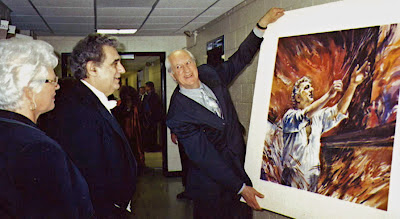Written on the wind.
Early
in 2008 the composer Huang Ruo called me from New York. He was working on a commission for a
piece for the Chinese pipa and voice, for the pipa virtuoso Min Xiao-Fen. Would I like to join in, make this an
audio-visual piece and send him some images? Urgent! Three movements: slow, faster, fastest, about twelve or thirteen minutes. Written on the Wind: a Multi-media
Drama for Pipa, Voice and Kinetic Painting, to be premiered in New York
on March 19th.
That was the only information I was given, but I knew
Min Xiao-Fen’s style and sound (I had heard her perform in Holland several
times) and of course I knew Huang Ruo’s style very well. This
was an interesting and really significant role reversal for me: create the
images without the music, rather
than from the music! So I created a variety of
kinetic visual sequences that to me suggested the sounds, rhythms, tempi, etc.
typical of their style. I heard the sounds in my head and created the whole
piece within a week. But the
question was, would it rhyme with what Huang Ruo had in mind?
 |
| Three images from the first sequences of Written on the Wind, for pipa, voice and kinetic painting. Symphony Space, New York, 2008. |
Fortunately, when my DVD arrived in New York, HR
really loved the images and immediately found musical potential in them. By now he and I have such a close
creative rapport that our parallel creative efforts in Amsterdam and New York
meshed as though we had been working in the same room. We each gave the images and the music
an intrinsic flexibility, so that each time Min Xiao-Fen plays the piece there
are numerous possible options for synchronicity and the beauty of surprise. At the première we felt we had reached a
new level of achievement, something much more than mere interdisciplinary
accompaniment. Min Xiao-Fen’s
artistry, fabulous pipa technique and dramatic vocal range of exotic sounds,
expressed in a mysterious song without words, fulfilled all our hopes.
Exceptionally, at these concerts I was not painting
live: my DVD was projected by a video-beamer. This was the only option those occasions, but it felt really
frustrating. The image quality was
poor and full of pixels and I felt helpless, unable to adjust my visual tempi
to Min’s performance. But both in New York’s Symphony Space and in Suny
Purchase University it went astonishingly well. We were thrilled with so many warm reactions from
individuals who had been touched by the three-way synergy.
Huang Ruo wrote a lovely programme note:
“What is written on the wind, will be kept and
carried away by the wind
…”
“We have worked closely together so that the music
and images develop simultaneously, sometimes occurring synchronously and at
other times happening asynchronously. The goal is to create a context of
artistic freedom and randomness so that the music, kinetic-painting, and live
performance each exist freely, but also respond to one another. An
interesting aspect of our collaboration is that neither of us told the others
what was written on the wind. For me, it is my own secret, which has been
buried in the music.”
A week later, walking home from my Amsterdam studio,
I was thinking about something I learned from having to sit and watch my DVD in
New York, instead of painting live.
I had seen it four times (including rehearsals) as Xiao-Fen played. Each time it was different in terms of
synchronization, yet each time it worked beautifully! The flexible energy both of Huang Ruo’s composition and of my design
gave the freedom to the spectator (me, in this case) to discover slightly
different relationships/synergy in the piece each time. I realized more clearly than ever how
Huang Ruo and I could trust each other in our creative process, confident that
whatever we do will be well crafted and designed, but will also have this
potential of flexibility, of spontaneous balance. Why did it take so long for me to gain this insight? Some words came to mind, written
by the prolific Japanese artist Hokusai (1760-1849):
“From the age of six, I had the habit of
sketching from life. I became an
artist…and from fifty on began producing works that won some reputation, but
nothing I did before the age of seventy was worthy of attention. At seventy-three, I began to grasp the
structures of birds and beasts, insects and fish and of the way plants
grow. If I go on trying, I will
surely understand them better by the time I am eighty-six, so that by ninety, I
will have penetrated to their essential nature. At one hundred, I may well have a positively divine
understanding of them, while at hundred and thirty, forty or more I will have
reached the stage where every dot and every stroke I paint will be alive. May Heaven, that grants long life, give
me a chance to prove that this is no lie”.
At seventy-eight, I’m just getting into my stride.
__________________________________________________
Next Monday: Where’s the Right Critic for my Kinetic Painting to
Music?










